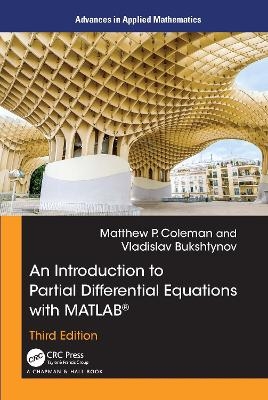
An Introduction to Partial Differential Equations with MATLAB
Chapman & Hall/CRC (Verlag)
978-1-032-63938-3 (ISBN)
The first two editions of An Introduction to Partial Differential Equations with MATLAB® gained popularity among instructors and students at various universities throughout the world. Plain mathematical language is used in a friendly manner to provide a basic introduction to partial differential equations (PDEs).
Suitable for a one- or two-semester introduction to PDEs and Fourier series, the book strives to provide physical, mathematical, and historical motivation for each topic. Equations are studied based on method of solution, rather than on type of equation.
This third edition of this popular textbook updates the structure of the book by increasing the role of the computational portion, compared to previous editions. The redesigned content will be extremely useful for students of mathematics, physics, and engineering who would like to focus on the practical aspects of the study of PDEs, without sacrificing mathematical rigor. The authors have maintained flexibility in the order of topics.
In addition, students will be able to use what they have learned in some later courses (for example, courses in numerical analysis, optimization, and PDE-based programming). Included in this new edition is a substantial amount of material on reviewing computational methods for solving ODEs (symbolically and numerically), visualizing solutions of PDEs, using MATLAB®'s symbolic programming toolbox, and applying various schemes from numerical analysis, along with suggestions for topics of course projects.
Students will use sample MATLAB® or Python codes available online for their practical experiments and for completing computational lab assignments and course projects.
Dr. Matthew P. Coleman is a Professor Emeritus of Mathematics at Fairfield University, CT, where he taught from 1989 until his retirement in 2019. He received his Ph.D. in Applied Mathematics from Penn State University in 1989 under the guidance of Dr. Goong Chen. While at Fairfield, Dr. Coleman taught almost every undergraduate course in the curriculum, along with a number of graduate courses. In addition, he was department chair for ten years, did a brief stint as associate dean (though he was happy when it was over!), and was a visitor at Texas A&M, NYU, and National Taiwan University. Dr. Coleman’s main research area is Control Theory and, more specifically, the vibration and damping of distributed systems. He has published numerous articles in this area, while collaborating with people from numerous universities, in mathematics, physics, and various branches of engineering. In addition, he has authored the first two editions of the textbook “An Introduction to Partial Differential Equations with MATLAB”. Dr. Vladislav Bukshtynov is an Assistant Professor at the Dept. of Mathematical Sciences of Florida Institute of Technology (Florida Tech) since 2015 after finishing his 3-year postdoctoral term at the Dept. of Energy Resources Engineering at Stanford University and having his Ph.D. degree in Computational Engineering & Science at McMaster University in 2012. As a Professor, he actively teaches and advises students from various fields: applied and computational math, operations research, and different engineering majors. His teaching experience includes Multivariable Calculus, Honors ODE/PDE courses for undergrad students, Applied Discrete Math, and Linear/Nonlinear Optimization for senior undergrads and graduates. As a researcher, Dr. Bukshtynov leads his research group with several dynamic scientific directions and ongoing collaborations for various cross-institutional and interdisciplinary projects. His current interests lie in but are not limited to the areas of applied and computational mathematics focusing on combining theoretical and numerical methods for various problems in computational/numerical optimization, control theory, and inverse problems. Besides being an expert in applying numerous optimization techniques, either analytically or numerically, Dr. Bukshtynov’s expertise includes PDE-based modeling for various engineering applications. For example, he pioneered system reduction techniques using a 4D VAR method and earned the 2012 Cecil Graham Doctoral Dissertation Award from Canadian Applied and Industrial Mathematics Society (CAIMS). At Stanford, he was part of a large collaborative research project to develop efficient computational and optimization algorithms for solving oil field management problems for petroleum reservoir models. At Florida Tech, Dr. Bukshtynov develops novel techniques suitable for reconstructing medical/computational images via solving inverse problems using multiscale simulation and optimization, optimal solution space multilevel parameterization, dynamical re-parameterization, and numerical methods for regularization. In addition, he has profound expertise in HPC programming. His particular strength is his ability to create hybrid computational frameworks by combining and tuning for optimal joint work scientific software of various types. As one of many examples, Dr. Bukshtynov is an author and active developer of EIT-OPT, an all-purpose open-structure multifaceted optimization framework for reconstructing biomedical images and early cancer detection via electrical impedance tomography. In 2023, Dr. Bukshtynov published a book “Computational Optimization: Success in Practice” with CRC Press to share his extensive experience in practical aspects of computational optimization with graduate students of math, computer science, engineering, and all who explore optimization techniques at different levels for educational or research purposes.
Chapter 1. Introduction. Chapter 2. The Big Three PDEs. Chapter 3. Using MATLAB for Solving Differential Equations and Visualizing Solutions. Chapter 4. Fourier Series. Chapter 5. Solving the Big Three PDEs on Finite Domains. Chapter 6. Review of Numerical Methods for Solving ODEs. Chapter 7. Solving PDEs Using Finite Difference Approximations. Chapter 8. Integral Transforms. Chapter 9. Using MATLAB's Symbolic Math Toolbox with Integral Transforms. Chapter 10. PDEs in Higher Dimensions. Chapter 11. Overview of Spectral, Finite Element, and Finite Volume Methods.
| Erscheinungsdatum | 11.07.2024 |
|---|---|
| Reihe/Serie | Advances in Applied Mathematics |
| Zusatzinfo | 133 Halftones, color; 133 Illustrations, black and white |
| Sprache | englisch |
| Maße | 156 x 234 mm |
| Gewicht | 1100 g |
| Themenwelt | Mathematik / Informatik ► Mathematik ► Analysis |
| Mathematik / Informatik ► Mathematik ► Angewandte Mathematik | |
| Technik ► Umwelttechnik / Biotechnologie | |
| ISBN-10 | 1-032-63938-5 / 1032639385 |
| ISBN-13 | 978-1-032-63938-3 / 9781032639383 |
| Zustand | Neuware |
| Informationen gemäß Produktsicherheitsverordnung (GPSR) | |
| Haben Sie eine Frage zum Produkt? |
aus dem Bereich


